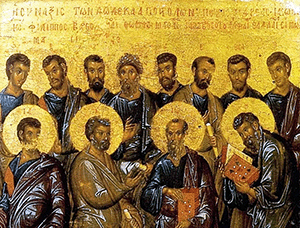
Followers of Jesus

The term disciple has become so common after two thousand years of Christian history that many never think about what it actually meant in Jesus’ time. From where does this term originally come?
The entire New Testament was written in Greek and the biblical Greek word we translate as “disciple,” is mathetes. In ancient Greece, a mathetes was the student of a philosopher. However, a disciple was not simply someone who listened to lectures or read the writings of a philosopher, but was one who lived day to day with the teacher, followed his example and, in some ways, actually tried to become a living reflection of the teacher.
This makes sense with the 12 disciples of Jesus as it is clear from the New Testament that they were with him day in and day out, learning from him and likely attempting to imitate his way of life.
Disciples and Apostles
As some of Jesus' disciples are also called apostles in the New Testament, we must define "apostle." The Greek word is apostolos, which means “one who is sent, a messenger.” In Luke 10, mention is made of 70 apostles whom Jesus sent out to preach. These others were likely followers of Jesus while the twelve disciples/apostles were Jesus’ inner circle. Paul, who never met the earthly Jesus, is thus never called a disciple, but considers himself an apostle, having been sent to preach to Gentiles by the resurrected Jesus.
The Synoptic Gospels largely agree regarding the identity of the 12 disciples Jesus called during his lifetime. However, the Gospel of John does not provide a clear list and mentions some different names. The disciple names common to all four Gospels are Simon Peter, Andrew, James and John, Philip, Bartholomew, Thomas, and Judas Iscariot. The rest are mentioned in some Gospels but not all. See Table
Backgrounds of the Apostles

The first disciples Jesus calls in the Synoptic Gospels are brothers, Peter and Andrew, together with two other brothers, James and John. These four are presumed to have known each other since they were all fishermen in Galilee. According to all the Gospels, they all abandoned their professions (and probably their families) to follow Jesus. Another disciple, sometimes called Matthew (Hebrew name,Levi), is said to have been a tax collector. This was considered a sinful profession by most Jews since he was collecting taxes for the hated Romans.
How the other disciples made their livings isn't made clear, but one can make guesses based upon clues in the text. Because Philip was also from the fishing town of Bethsaida in Galilee, many suggest he had connection to the fishing trade. The disciple, Thomas, (a.k.a. Didymus), is a more enigmatic figure in the Gospels, but is said to have been a carpenter in the Acts of Thomas, a 3rd-century apocyrphal text.
Simon the Zealot's title suggests a political affiliation with the Zealots, a group known for their radical opposition to Roman rule. This, however, provides us no insight into his actual profession.
Finally, Judas Iscariot, (the infamous betrayer of Jesus), is said to have been in charge of the group's money, (John 12:6; 13:29) implying a role based upon financial knowledge. This is made more compelling since we know Matthew's profession as tax collector also involved stewardship over money. It would therefore seem odd that Judas would become the group's treasurer unless his profession uniquely qualified him to be a better choice than Matthew.
Hierarchy
Although all twelve disciples were all chosen by Jesus, he seems to have given three of the twelve a special status. Peter, James, and John became Jesus’ inner circle, sharing knowledge and experiences with Jesus that the other disciples didn't. (They are also referred to as the Pillars of the Church in Paul’s letters.) These three were the only ones present at Jesus’ Transfiguration and were with Jesus in the Garden of Gethsemane before his arrest. Jesus' closeness with these three is also hinted at by his provision of nicknames for them. He called Peter "Cephas," which means “rock” in Aramaic, (translated into the Greek word, Petros). Matthew 16:18 says this is because Peter is the “rock” upon which Jesus would build his church. The Gospels also tell us that Jesus called James and John “sons of thunder,” although we are not told why.
Other Disciples
In Mark, our earliest written Gospel, most of the 12 disciples are chosen by Jesus from a number of other followers. Matthew and Luke, using Mark as a source, tell much the same story, although Matthew/Levi the tax collector is called separately. John's Gospel reported that Jesus called Philip who then called his brother Nathanael. This brother's name is not mentioned in the Synoptics but is traditionally associated with Bartholomew. After providing us the names of these other disciples, the Gospels say little else about them.
The earliest written reference to the 12 disciples appears in one of Paul’s letters, 1 Corinthians 15:3-5: "For I handed on to you as of first importance what I in turn had received: that Christ died for our sins in accordance with the scriptures and that he was buried and that he was raised on the third day in accordance with the scriptures and that he appeared to Cephas, then to the twelve."
Thus it appears that Paul (and the early Church) believed that Jesus had a special relationship with Peter who saw the resurrected Jesus first. Although he later appeared to "the 12," the scriptures don't name the others in this reference.
